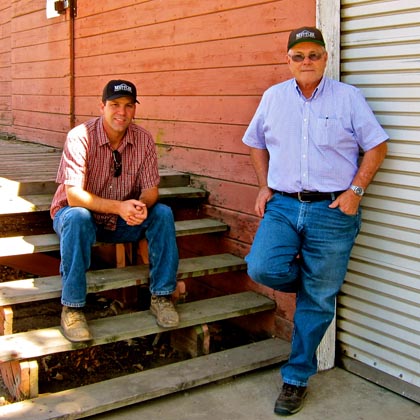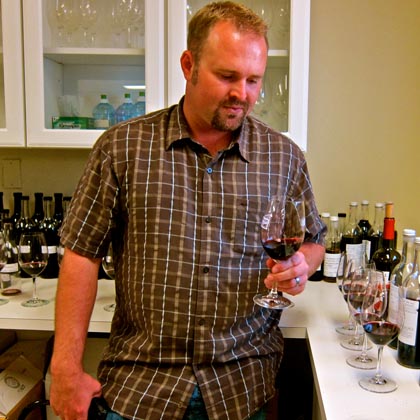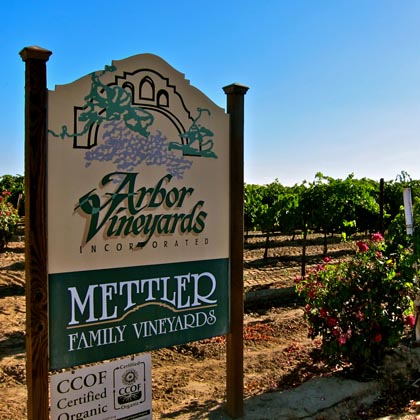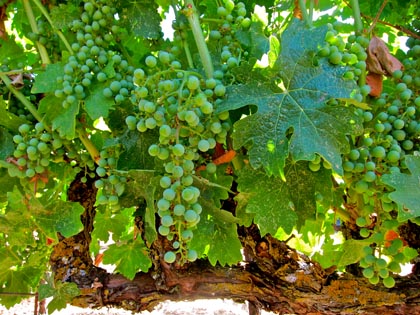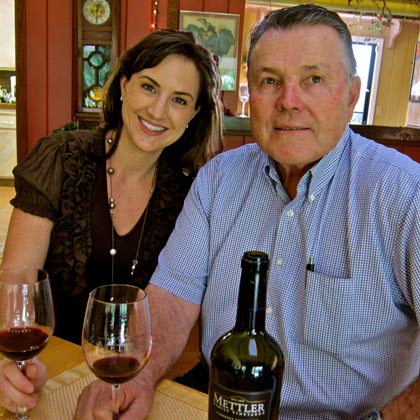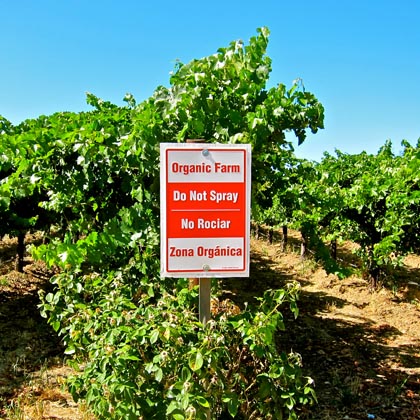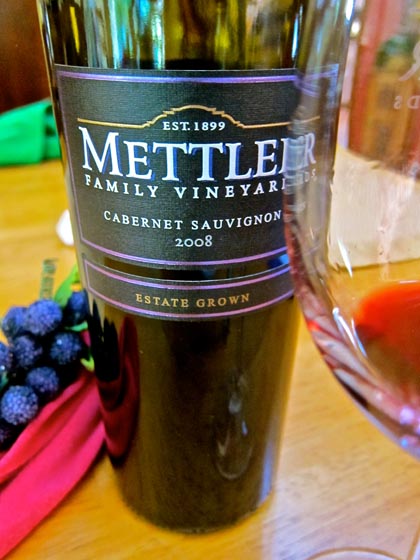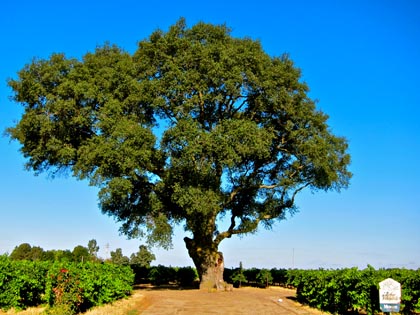Letters from Lodi
An insightful and objective look at viticulture and winemaking from the Lodi
Appellation and the growers and vintners behind these crafts. Told from the
perspective of multi-award winning wine journalist, Randy Caparoso.
Mettler family’s runaway success
Larry Mettler with Jason Eells, mid-July 2011
A family’s history of farming and excellence
The decision to establish Mettler Family Vineyards as a brand and winery was, indeed, a “family decision,” says Adam Mettler. There is a lot of lineage as well as huge amount of talent associated with the name. Start with Adam Mettler, who is not only the family winemaker, but who also holds down a pretty respectable “day job” as GM/winemaker of Michael~David Winery, none less.
Adam Mettler
Adam’s dad, Larry Mettler, heads up the family and their grape business (Arbor Vineyards), which farms over 800 acres of numero uno quality Lodi vineyards – 300 of those acres owned by the family, including 75 acres certified organic by CCOF (California Certified Organic Farmers), and an even bigger chunk responsibly farmed according to Lodi Rules for Sustainable Winegrowing.
Larry had taken over the family business in 1970 from his dad Carl, who was a sixth generation farmer. Carl’s grandfather, George Mettler, was one of five brothers who immigrated from Germany to South Dakota in the mid-1800s, and soon after trickled down to San Joaquin Valley (hence, the multiplicity of close-to-distantly related Mettlers in the Lodi area).
But according to Adam, it was his mother, Charlene Mettler, who pushed and prodded the family to come together and “take it to the next level,” back in 1998. Adam’s older sister, Kim Mettler-Eells, took on the role as marketer, younger sister Kelli has been immersed in sales, and Kim’s husband, Jason Eells, works as vineyard manager.
Because Carl and Larry had been working for years with multiple clones of Cabernet Sauvignon – including research projects with U.C. Davis – the decision was made to specialize in that grape. “Cabernet Sauvignon seemed to us to be the path of least resistance,” says Larry. “It gave us a chance to set ourselves apart from other Lodi producers coming up at the time.”
While doing so, the Mettlers established the fact that Cabernet Sauvignon can indeed flourish in the Lodi AVA’s Mediterranean climate. The very first vintage of Mettler Lodi Cabernet Sauvignon, a 1999, was ranked among the Wine Spectator’s “Top 100 Cabernet Sauvignons in the World,” and subsequent vintages have fared just as well. Both the 2006 and 2007 vintages of Mettler Cabernet Sauvignon garnered Gold Medals in the prestigious San Francisco Chronicle Wine Competition, and the currently released 2008 recently took a Gold at the California State Fair.
Put the quality of the grapes and skilled winemaking together with Kim’s marketing leadership and Kelli’s energy, and you get the Mettler formula for success: yearly production now approaching 10,000 cases (about 75% of that Cabernet Sauvignon, and the rest Zinfandel and Petite Sirah), successful distribution in 35 states. All this accomplished without even having an official Mettler tasting room… that is, until (knock on oak) this coming December: this past July the family announced the purchase the Vino Con Brio Winery on E. Harney Lane (with the surrounding vineyard and attached Amorosa Inn & Gardens), and plans for a redesign are being drawn up as we speak. Mettler’s legion of loyal followers will soon have a place to park their swords!
Specializing in Cabernet Sauvignon in the heart of zin country
Despite the critical success, Adam tells us, “Lodi cabernet wasn’t an ‘easy’ sell, but we’ve managed to develop a following.” Recalls Larry, “I first took it as a challenge, in the mid-‘60s while I was studying viticulture and oenology at Fresno, when a professor told me Lodi was too warm for Cabernet Sauvignon.”
Mettler grown Cabernet Sauvignon, July 2011
It seems that even the professors back then were unaware of the fact that Lodi’s climate really is no different than, say, the center of Napa Valley. Picking up from where his father Carl left off with research on the ideal clones and rootstocks suited to Lodi’s deep soils, Larry’s hard work and persistence eventually quieted the naysayers. “How you farm is more important than clones anyhow,” adds Eells – “it helps that Larry has always had farming in the blood.”
Kim Mettler-Eells & Larry Mettler
All grape farmers, of course, know that vintages also matter – one year one block can produce the best grapes, and the next year it’s another. Another reason Mettler Cabernet Sauvignon has proven so successful: they can cherry-pick each year. “No more than 5%, 6% of what we grow goes into Mettler wines,” says Adam. “Jason and my dad can make the decisions each year, even right during harvest, based upon what’s happening in the vineyard, as to which cabernet we keep and which cabernet we sell.“ Yet, Larry reminds us, “even what we sell is considered A-#1, which is why there is never have a problem with clients. We’ll make further decisions after the wine is made – the cabernet that doesn’t make the cut in the winery, we move out through the bulk market or sell directly to other wineries.”
As efficacious as Mettler’s Cabernet Sauvignon program has been in medal judgings and blind tastings, even when stacked up against wines from more vaunted regions in California, Adam says you really can’t make comparisons. “Lodi is a more fruit forward style. A big plus is that we don’t so much of the pyrazines (i.e.,flavor compounds called methoxypyrazines, which give Cabernet Sauvignons their characteristic bell peppery or vegetal tastes) that you often get in cooler climate regions. Yet we do have our cooler vintages (examples: 2010, and so far in 2011, which is running two to three weeks late). This is why good farming, and keeping crop levels low enough for fruit to ripen optimally, is just as important in Lodi as anywhere else.
“One of the drawbacks is that our cabernet struggles with getting a full tannin structure,” Adam adds, “unlike Napa Valley, which achieves that easily. We try to extract more tannin by doing later pressing (i.e. separating fermenting juice from skins, which contain most of a grape’s tannin and flavor) and fermenting all the way with the skins.
“We’re also not being afraid of using new oak (Mettlers are typically aged in 85% to sometimes 100% new French oak)…. we feel that if you’re going to spend more than $20 for a wine, you should get your money’s worth. We’re striving to make a cabernet that rivals Napa Valley’s; but still, a cabernet grown in Lodi will usually be a more approachable one.”
Certified organic Mettler planting
The Mettlers do what they say and say what they do. How refreshing to count on that. You can also eventually expect, Kim tells us, a little more diversity of product once their tasting room is up and running (Kelli will be taking on many of the hands-on responsibilities when that happens). Larry says that there is even the possibility of some sort of Mettler white wine. Why not? If Dylan could do country, if Sugar Ray and Holyfield could dance with stars, surely the Mettlers could kick butt when they get around to whites.
In the meantime, the existing three varietal line-up remains, pound per pound, the most impressive in the Delta. Notes on current and upcoming vintages:
2008 Mettler, Epicenter Lodi Old Vine Zinfandel ($18) – “Epicenter” refers to Lodi’s place in the world of Zinfandel (the AVA crushes over 40% of the grape grown in California). Fragrant, almost violet-like note to red berry/black cherry aroma, embellished by sweet vanillin, smoky oak, lending sausage spice-like qualities (suggesting fennel, black pepper and sage). Medium-full, firm body with a profile leaning towards a lean (as opposed to fat), sinewy side; the spiced berry flavors wrap in remnants of silk, brightened by zesty acidity, with still-sturdy tannin adding an edgy attitude to the finish. Blended with 11% Petite Sirah
2009 Mettler, Epicenter Lodi Old Vine Zinfandel ($18) – This vintage is scheduled for an October release, and it is a tad bigger than the ’08 (close to 16% alcohol), while sporting markedly more layers, a tighter harmony of sensations, and fruit qualities skewed towards the darker side of the varietal character (more blackberry than raspberry/cherry). The aromas are sweetly oaked and generous, per the house style (which is decidedly masculine); beefy and full on the palate, with velvet qualities punched up by the oak, a zesty edge and confluence of fruit and oak tannin.
2008 Mettler, Lodi Petite Sirah ($22) – Most Petite Sirah aficionados like ‘em big and rambunctious, and you don’t always get that these days. Mettler sticks to the game plan, starting with a properly purplish-ruby, inky color, a sweetly ripened blueberry aroma, splashes of smoky, toasted oak, and a chocolaty thick, dense texture. If you’re looking for subtlety, you’re in the wrong place, my friend. Yet the tannins and oak are also sweetly rounded – there’s a nice, fleshy feel to the middle – and the wine finishes with a drop of balsamic-like richness. Beefed up by 5% Cabernet Sauvignon.
2009 Mettler, Lodi Petite Sirah ($22) – Another upcoming fall release, and as black as a wine can be, with the purplish-ruby tinge. The ’09 feels bigger yet tastes plusher, more compact than the ‘08, which is a good thing, because you always want your Petite to come with merciful measures of composure. In this case, a tightly wound, sweet toned nose teeming with earthen spices (like twists of cracked black pepper, cumin and anise seed); at this writing, predominating even over the sweetly oaked, generously fruited Mettler signature. In the middle, the spiced fruit start to turn cassis-like (i.e. suggesting blackcurrant berry liqueur) in richness and consistency, adding sensuousness to the sinew. Oh, you’re gonna love this…
2008 Mettler, Estate Grown Lodi Cabernet Sauvignon ($22) – The suggested retail price of this wine also suggests why it has been a runaway success: hard to find a cabernet anywhere that gives you as much lavish varietal intensity for the price. The nose is pungent with dark fruit (blackcurrant, purple plums, black cherry) with little whiffs of licorice to go with the aromatic oak (steaming dark roasted mocha-coffee). The taste full, fleshy, velvety, svelte and even-keeled, filled to the top with plummy fruit ingrained with well rounded fruit and oak tannin. At the core, a manly sort of wine, with a gentle, sweet side; like the stubbled hunk who cooks you breakfast in the morning. But don’t expect him to start spewing feelings – what more do you want?
Gigantic ancient oak on Alpine Rd., amidst Mettler farmed Merlot
